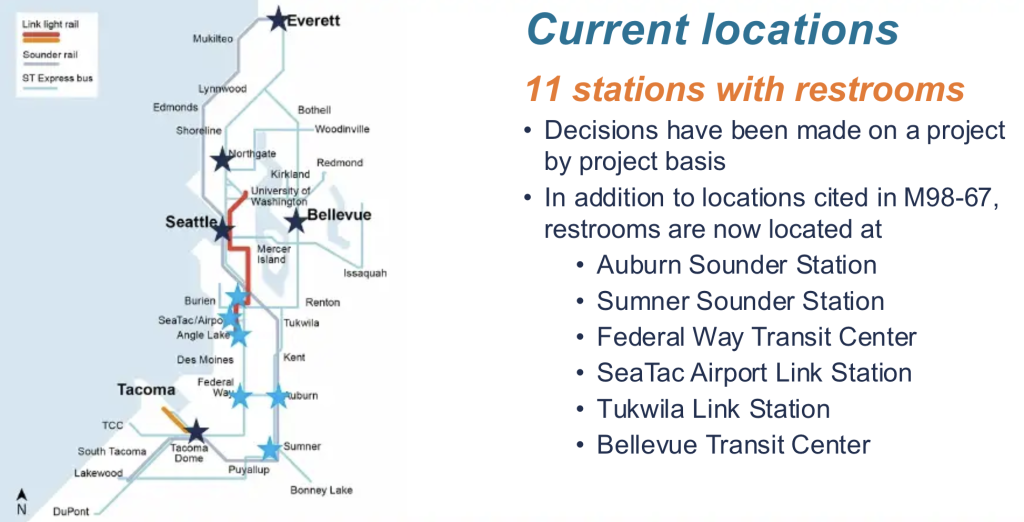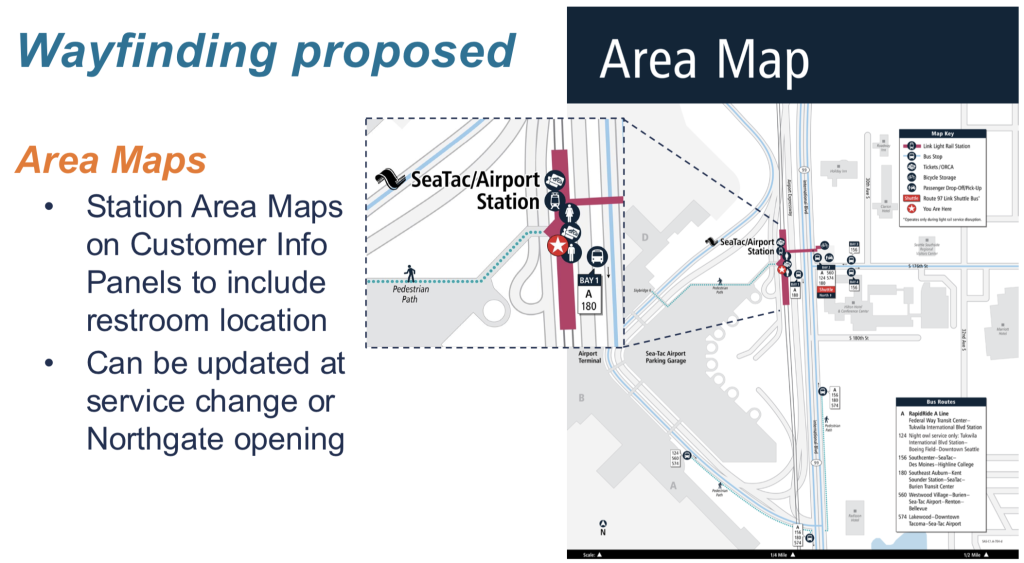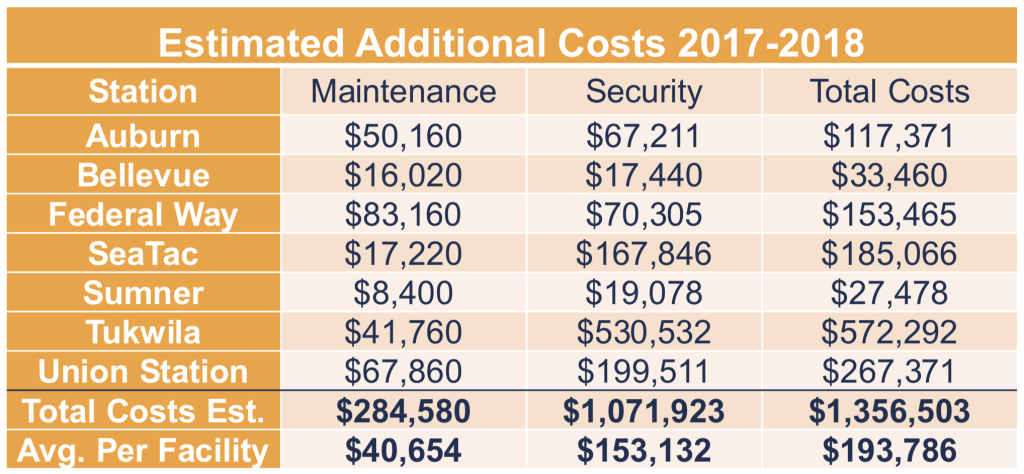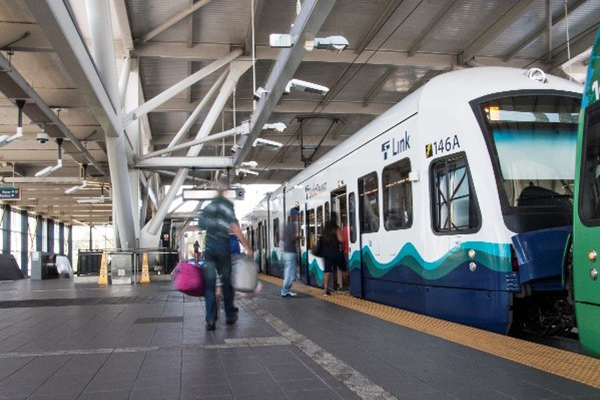Sound Transit is taking another look at its restroom policy at the direction of boardmembers. In a briefing last month, staff provided an overview of the existing restroom program, policy considerations, and approach to explore possible changes. Staff took great lengths to emphasize the challenges that the transit agency experiences with restrooms and their costs. But additional restroom facilities are poised to open in the next few years as light rail is expanded into suburban communities.
Existing policy for bathroom facilities comes from a 1998 motion that outlined the principles on how bathrooms should be located at Sound Transit facilities. Even then, the ambitions for restrooms were very low, with a preference for onboard commuter rail bathrooms and heavily used transit hub locations.

Stated policies in the motion also urged cost-sharing with other service providers and agencies and prescribed heavy monitoring and security protocols out of fear of abuse.
So far, Sound Transit only has 11 locations with public restroom facilities. Two of these are in Seattle (Union Station and Northgate Transit Center) while the rest are located in other cities served by the transit agency. Notably, no light rail facilities in Seattle have restroom facilities yet all of the light rail stations in Tukwila and SeaTac do. Several Sounder commuter rail stations have restroom facilities in addition to Bellevue Transit Center and Federal Way Transit Center, and all Sounder trains have onboard restroom facilities, required by Motion No. M98-67.

By 2024, the number of Sound Transit facilities with restrooms will jump to 18. Nearly all new restrooms, with the exception of Northgate, will be located in suburban cities. Sound Transit often installs restrooms because cities require the transit agency to construct them. For instance, Kent’s land use code specifically requires restroom facilities for light rail stations like its neighbor SeaTac.

Sound Transit has adopted several design and operational strategies for new public restrooms, such as:
- Having at least two accessible unisex restrooms;
- Using fixtures and materials in restrooms that require minimal maintenance and damage-resistant;
- Video surveillance located just outside of the restroom area;
- Requiring restroom users to contact security staff for remote access to facilities;
- Limiting hours of use to only operational hours of transit; and
- Locating them within a fare-paid zone whenever possible.
In addition to the current standards for restroom design, Sound Transit is looking into other solutions to enhance customer access. One option would be adding access to restrooms via an activated ORCA card (tapped before entering the fair-paid area) or bar code scanning system for riders with other fare media.

To promote the use of existing restroom facilities, staff noted that interactive and printed maps will be updated to highlight their existence. The online map will include a new layer that specifically identifies restroom facilities for trip planning purposes. Printed and wayfinding maps will be updated to include specific restroom icons in the future. Relatedly, Sound Transit plans to overhaul signage in existing stations by converting gendered blade and wall signage to unisex signage.

An option to expand the number of restrooms is to use leased retail facilities as a means to open up restroom access. At Angle Lake Station, Sound Transit was required to install leasable retail space as part of the parking garage to activate the ground floor. So far, the transit agency has been unsuccessful in getting a tenant to lease the space. But staff suggested that terms of lease could include a requirement that associated restrooms be accessible to the general public, including riders.
Sound Transit staff touched on travel times for riders of light rail. Riders spent an average of 18 minutes on light rail in 2018 since most trips are short in distance. Travel time from Downtown Seattle to Sea-Tac International Airport average about 38 minutes, but the proportion of riders who travel that distance is relatively small. As the system grows and riders travel longer distances, however, average travel times will likely grow. Trips from Federal Way and Everett to Downtown Seattle are projected to take 53 minutes and 60 minutes respectively on light rail, which staff suggested may add more urgency to offer more restroom facilities.
Staff presented a litany of issues with restrooms. Ongoing maintenance from misuse of restrooms was a big grievance since graffiti removal and repair from other vandalism are common problems, in addition to the normal cleaning requirements of facilities. The kinds of damage from misuse of restrooms spans arson, fire extinguisher tampering, removal and distortion of fixtures, and clogged toilets from clothes and drug paraphernalia. Sound Transit stressed that there were over 2,250 separate incidents at just seven locations with restrooms over a two-period (2017 and 2018), which totaled $284,580 in maintenance costs for the transit agency. To put that in perspective, Sound Transit’s total transit operating budget is $345.4 million in 2019.
Security and police response to restroom misuse was another area of significant concern by staff who characterized restrooms as “magnets for criminal activity,” suggesting more than just petty vandalism and careless use. Sound Transit staff noted that there were over 130 separate incidents requiring security and police response to restroom misuse over the 2017-2018 time period, translating to 35,216 hours of staff time. Many of these incidents involved serious vandalism, drug activity, and prostitution, which has led several agency partners to encourage Sound Transit to close public restrooms or no longer provide them in future facilities.

During the 2017-2018 timespan, Sound Transit spent on average $193,786 per facility among seven highlighted locations. Tuwkila International-Boulevard Station, a light rail station, was the priciest with over $572,000 in costs, the bulk of which went toward security. Sumner Station, a commuter rail station, was the cheapest with just under $27,500 in costs, again with the bulk of spending on security. In fact, most restroom facility security costs were more than triple the actual cost of maintenance.
For now, Sound Transit will continue to engage riders about how to improve restrooms and the rider experience as well as developing formal policy options with cost estimates to expand restroom access. That information will be brought forward for consideration by the board at a future meeting, though the timing is yet to determined.
The featured image is courtesy of Sound Transit.
Stephen is a professional urban planner in Puget Sound with a passion for sustainable, livable, and diverse cities. He is especially interested in how policies, regulations, and programs can promote positive outcomes for communities. With stints in great cities like Bellingham and Cork, Stephen currently lives in Seattle. He primarily covers land use and transportation issues and has been with The Urbanist since 2014.



